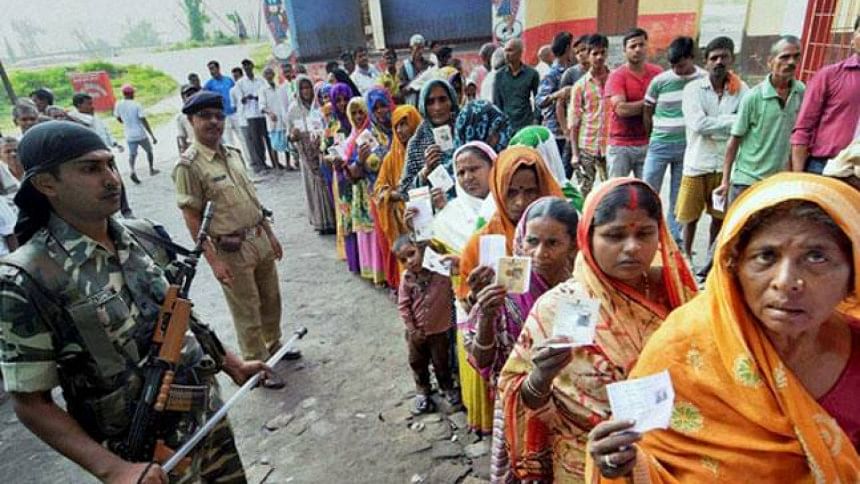Assam's Assembly election and Bangladesh

It is interesting that the election to Assam's legislative assembly in India has aroused much debate recently. The election is expected to be held in two phases on April 4 and April 11 this year. Seats in all 126 constituencies are up for grabs; a political party will need 64 seats to attain a majority. The Congress now holds 78 seats, and its leader Tarun Gogoi is the current chief minister of Assam. The tenure of the present Assam assembly ends on June 5. Since Assam is an adjoining province of Bangladesh, it is natural for us to take a deeper interest in the ongoings in the state.
Prior to this election, the Indian National Register of Citizens was updated only this January. In fact, the Supreme Court of India was monitoring this update. 1.92 crore voters has been recorded for this election. The main reason behind this detailed updating of the electoral roll is to check what the voters in Assam, as well as the political leaders there, consider "illegal immigration from Bangladesh" to Assam as "very alarming".
In order to attract voters to vote for the Congress Party in the coming elections, Chief Minister Gogoi announced that if his party returned to power with a majority, he would supply rice at Rs 2 per kg and build religion bhawans. On the other hand, Congress' main challenger, the BJP headed by Prime Minister Modi has, through Home Minister Rajnath Singh, pledged that they would complete the fencing along the Bangladesh-India border to bar any future illegal immigrants from Bangladesh entering Assam. Assam shares a 263 km long border with Bangladesh, out of the 4,096 km long international border between the two countries. Yet, about 44 km of the boundary passing between the two countries has no fencing, and there's little hope that one can be built in the future, as the Brahmaputra River flows between these two territories.
In Assam, the religious configuration is 61.5 percent Hindus and 34.22 percent Muslims. The Christian populace is only 3.7 percent of the total Assamese population. It must be noted that Muslims came there about eight centuries back. In fact, out of the 32 districts in Assam, nine are Muslim majority, according to a 2011 Assam census. It should be noted that before the Partition of India in 1947, internal movement was commonplace between the regions of what is now Bangladesh and the regions of Assam and West Bengal. During the pre-partition days, Assam was thinly populated, and the British colonial government was keen to exploit the rich resources of this region. It, therefore, did not mind the movement of people from northern India, West Bengal and the present territories of Bangladesh. During the Liberation War of Bangladesh in 1971, about 10 million Bangalees had moved to different parts of India. There was also a moderate flow of Bangalees to nearby Assam. However, after the end of the war, there was a flow back of the temporary exodus. Yet, in 1978, it was noted by some Assamese observers that about 45,000 Bangalee names were in the electoral roll of Assam. But they were of Hindu religious persuasion. Thus, by 1982, the agitation by Assamese to deport these people to Bangladesh petered out. However, by the end of 1982, the Indian central government had called elections in Assam and triggered the movement to deport this small group. As a consequence, it led to the 1983 Nellie massacre, which was followed by the All Assam Students Union calling for whole scale deportation of this group of migrants for economic reasons, but they did not resort to violent means. The Nellie massacre, however, was never subject to official investigation.
In 2015, the current president of BJP, Amit Shah, stated in Guwahati that his party would give citizenship to all Hindu migrants from Bangladesh, terming them as 'victims of religious persecution'. But we need to analyse the extent of this claim; as situations stand today, it would be hardly credible to state that there is religious persecution in Bangladesh or fewer economic opportunities for Hindus, when compared to India. Moreover, when one compares the state of the territories of Assam to Bangladesh, one would find it to be quite poor. With 6.2% annual growth and a greater diversification of the economy, one could argue that there is a larger flow of Indian citizens to Bangladesh now. The living conditions are better and there is better availability of jobs than in neighbouring Assam or even some other parts of India. There have been reports of more and more Indian citizens coming to Bangladesh as tourists, and overstaying their visa when they find gainful employment here. They send back large remittances to India informally. In 2012, Indians working in Bangladesh have reportedly sent $3.7 billion in remittance, as part of their pay from their employment in Bangladesh. Citizens of India, belonging to West Bengal, Meghalaya, Assam, Tripura and Mizoram, mostly work in the NGO, RMG, textiles and IT sector, and send back money through a hundi system.
It is now clear that the economy of Bangladesh is only improving, as the country is swiftly moving towards a middle income status. As this is in fact the case, there is less or no need for Bangladeshi themselves to seek their fortune in a less developed region like Assam.
The writer is a former ambassador and a regular columnist.
E-Mail : ashfaque [email protected]

 For all latest news, follow The Daily Star's Google News channel.
For all latest news, follow The Daily Star's Google News channel. 



Comments